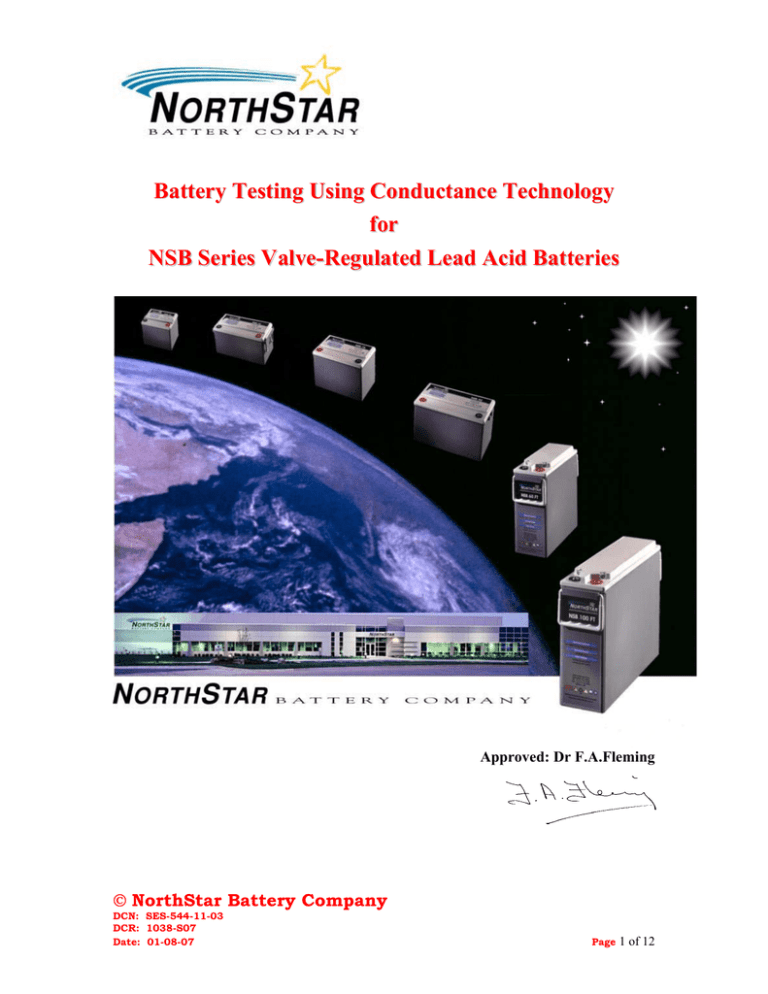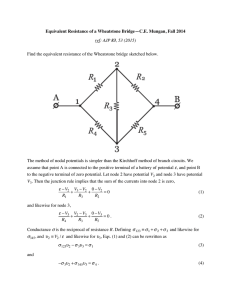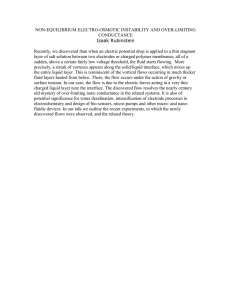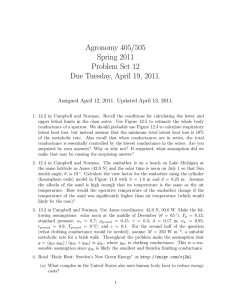Battery Testing Using Conductance Technology for NSB Series
advertisement

Battery Testing Using Conductance Technology for NSB Series Valve-Regulated Lead Acid Batteries Approved: Dr F.A.Fleming NorthStar Battery Company DCN: SES-544-11-03 DCR: 1038-S07 Date: 01-08-07 Page 1 of 12 Table of Contents Background-Principals behind conductance testing……………3 NSB Conductance Values………………………………………………..5 Effect of float duty conductance……………………………………….6 Effect of temperature on conductance……………………………….7 On-line versus Off-line conductance measurements……………..8 Effect of discharge on conductance…………………………………..9 Measurement of NSB Batteries using Midtronics Celltron-Ultra meter ………………………………………………………………..10 Off-line Conductance Measurements……………………………….11 On-line Conductance Measurements……………………………….12 NorthStar Battery Company DCN: SES-544-11-03 DCR: 1038-S07 Date: 01-08-07 Page 2 of 12 Battery Testing Using Conductance Technology Following a detailed study, NorthStar Battery LLC is happy to endorse the use of the Midtronics Celltron-Ultra meter as a state-of-health tool for their range of AGM lead-acid batteries. The following document details the principals behind conductance testing, the full range of NSB conductance values, what the limitations are and how to use the device in a correct manner. • Background The following section is purely background reading for anybody wishing to understand the principals behind conductance testing. An understanding of these principals is not required for the use of the Midtronics Celltron-Ultra meter. A simple RC equivalent circuit can be used to approximate the physiochemical properties of a lead-acid battery. Such a simplified equivalent circuit is shown below: CDL RS RP W IS W The above components are associated with some of the characteristics of the battery. 1. RS is called the serial resistance and represents the sum of all the resistive components within the battery such as the electronic resistance of the terminals, intercell connecting straps and lead grids, as well as the ionic resistance of the electrolyte. The magnitude of Rs is typically very small, approximately 0.001Ω for a 12V-100Ah AGM battery, and will increase as the battery is discharged or approaches the end of its useful life e.g. due to grid corrosion. NorthStar Battery Company DCN: SES-544-11-03 DCR: 1038-S07 Date: 01-08-07 Page 3 of 12 2. RP is the parallel resistance and is also known as the charge transfer resistance. This parameter represents the resistance associated with the electrons being transferred within the active materials during the electrochemical processes, e.g. Pb ↔ Pb2+ + 2e-. It is associated with the ability of the battery to be charged or discharged and is also very small in magnitude at approximately 0.001Ω for a 12V-100Ah AGM battery. This parallel resistance will also increase as the battery ages due to the active materials becoming increasingly less electro-active. 3. The third term CDL represents the capacitance associated with the large surface area of the battery plates and should not be confused with the capacity of the battery. It is the capacitance of a very thin layer created at the interface of the charged plates and the oppositely charged particles (ions) in the electrolyte. It is often referred to as the ‘double-layer capacitance’ and can be very large, in the order of several farads, depending on the battery design. This parameter decreases as the battery ages due to the progressive sulphation of the plates. 4. The next term, W, is known as the Warburg Impedance, and is a complex parameter that attempts to describe the diffusion of ions through the pores of the battery plates during the charge/discharge reactions. It changes with state-ofcharge and also throughout the batteries life. 5. The final component is the serial inductance, Is, this parameter is associated with the inductive properties of the terminals, the intercell connecting straps and the lead grids. This term tells us little about the condition of the battery and furthermore is largely invisible to conductance measurements. By passing an AC electrical signal and measuring the response it is possible to obtain a value for the magnitude of the impedance for this equivalent circuit. The frequency of the AC signal, however, is critical to deriving the maximum amount of information from all the components within this circuit. If the AC frequency is too high then no information regarding either RP or W is obtained, similarly if the AC frequency is too low then the contribution from CP is zero. The ideal frequency to gain the maximum information from this circuit, and hence the physiochemical properties of the NSB battery, is between 10 to 50Hz. The Midtronics Celltron-Ultra meter operates by measuring the battery at an optimized frequency within the above bandwidth. The device injects the AC signal, measures the transient response and then calculates the AC conductance of the battery. The AC conductance, or more correctly admittance, has units of reciprocal ohms (Ω-1) or Siemens (S), and decreases in magnitude as the battery ages, is discharged, or develops a fault. NorthStar Battery Company DCN: SES-544-11-03 DCR: 1038-S07 Date: 01-08-07 Page 4 of 12 • NSB Conductance Values The conductance values for the NSB range of 12V AGM batteries, in an as-new and also at an end-of-life condition, are listed in the following table. Battery NSB40 Conductance as-new @25°C (77F) /S 1052 Conductance at end-oflife@25°C (77F) /S 631 NSB70 1589 953 NSB75 1398 839 NSB90 1806 1083 NSB125 2103 1262 NSB40FT 1092 655 NSB60FT 1278 767 NSB90FT 1627 976 NSB100FT 1704 1023 NSB110FT 2159 1295 NSB130FT 2231 1339 NSB170FT 2455 1473 The above values have been obtained by statistical analysis of large sample sizes and take into consideration the marginal reduction in conductance as the battery conditions within the couple of weeks whilst on-float duty (see next section). The conductance at end-of-life is 60% of the as-new figure. This end-of-life value has been determined by accelerated float-life testing and correlating battery capacity with conductance. If the conductance of any battery approaches this minimum value then that battery should be considered to be approaching end-of-life, or is defective, and should be replaced. NorthStar Battery Company DCN: SES-544-11-03 DCR: 1038-S07 Date: 01-08-07 Page 5 of 12 • Effect of float duty on conductance New NSB batteries when first placed on float duty exhibit a marginal reduction in conductance over the first few weeks. The mean conductance and the mean ± 3 x standard deviation values are plotted against days on float in the following chart for a large group of new NSB batteries. 2100 Conductance /S 2000 1900 Mean + 3s Mean 1800 Mean - 3s As new 1700 1600 1500 0 10 20 30 40 50 60 70 80 90 100 Day on float Initially the batteries exhibit a mean conductance higher than the as-new value, however, over a period of approximately one month this value drops by approximately 5% until the (Mean – 3s)* approaches the as-new value. This behavior is typical of NSB AGM batteries and is simply due to the high saturation level found within the battery immediately following formation and its progressive reduction until the optimum recombination efficiency is achieved. *(Mean – 3s) is a value derived from the statistical analysis of a significant number of samples and is a minimum value that 99.7% of the population exceeds. NorthStar Battery Company DCN: SES-544-11-03 DCR: 1038-S07 Date: 01-08-07 Page 6 of 12 • Effect of temperature on conductance Measured battery conductance varies with temperature; this is because the ionic resistivity of the electrolyte and also the charge transfer resistance both decrease as the temperature increases and vice versa. Typically over a temperature range of 0 to 40°C the magnitude of conductivity changes by approximately 0.5%/°C, however, below 0°C the reduction in conductance is far more marked. 120% ~0.5%/°c Conductance 100% 80% 60% 40% 20% 0% -40 -20 0 20 40 60 80 Temperature /°C It should be noted that the Midtronics Celltron-Ultra meter has a temperature compensation factor built into it’s software, however, this factor only compensates for the temperature that the meter is recording at its inbuilt sensor and is not necessarily the temperature of the battery. NorthStar Battery Company DCN: SES-544-11-03 DCR: 1038-S07 Date: 01-08-07 Page 7 of 12 • On-line versus Off-line conductance measurements There is a very strong correlation between on-line and off-line conductance readings for the same battery as shown in the following chart. 2400 Conductance /S 2300 2200 2100 2000 Off-Line 1900 On-Line 1800 1 2 3 4 5 6 7 8 9 10 11 12 13 14 15 16 17 18 19 20 Battery Number One of the concerns associated with taking on-line conductance measurements is that the presence of any AC ripple could upset the accuracy of the reading. All Midtronics on-line testers i.e. Celltron-Ultra, Celltron-Advanced, Celltron-Essential and Digital Midtron, can be reasonably expected to provide accurate battery conductance measurements even if system noise, such as AC Ripple, is present. If, however, anomalous readings are recorded whilst the battery is on-line then it is advisable to repeat the measurements off-line and compare the values. NorthStar Battery Company DCN: SES-544-11-03 DCR: 1038-S07 Date: 01-08-07 Page 8 of 12 • Effect of discharge on conductance 120% 3000 100% 2500 80% 2000 60% 1500 40% 1000 20% 0% 100% 4C 500 C/10 80% Conductance /S Nominal Conductance In order to evaluate the effect of discharge, and hence state-of-charge, on the conductance reading, a group of NSB170FT batteries were continuously discharged at different rates whilst regularly recording the conductance value. 60% 40% 20% 0 0% SOC At the 4C rate (15-minute) the total energy available from the battery is only approximately 50% of the energy available at the C/20 rate. The conductance during this discharge increases initially due to the relative high current increasing the internal temperature of the battery. Following the initial warming up period the conductance progressively decreases until it reaches approximately 80% at the end-of-discharge. Immediately following the discharge the conductance increases back up to its former level; this behavior is consistent with the electrolyte not being fully depleted at the 4C rate and consequently its ionic conductivity increasing back to a higher level as the battery recovers from the high-rate discharge. At the C/10 rate the total energy available approaches that which is available at the C/20 rate. During the discharge the conductance decreases until it reaches approximately 40% at the end-of-discharge. In contrast to the 4C rate, the conductance following the discharge does not recover; this behavior can be explained by the fact that the acid has NorthStar Battery Company DCN: SES-544-11-03 DCR: 1038-S07 Date: 01-08-07 Page 9 of 12 now been completely depleted during the long slow discharge and as a consequence its ionic conductivity is very low. • Measurement of NSB Batteries using Midtronics Celltron-Ultra meter The best way to use conductance as a diagnostic tool in standby installations is not to solely use absolute values, i.e. the end-of-life value, but rather to look for trends or differences within a group. For example, one battery in this 48V system is clearly different from its partners, and furthermore is exhibiting a distinct downward trend. It should be treated as suspicious even though it is well above the minimum conductance acceptance value. 2200 Conductance /S 2000 1800 1600 1400 Minimum 1200 0.0 0.5 1.0 1.5 2.0 2.5 Duration /Years The following sections detail the recommended work instructions for taking conductance readings in a standby installation using the Midtronics Celltron-Ultra. For more detailed instructions on using this or any other Midtronics Conductance meter please visit the Midtronics web site at http://midtronics.com/. NorthStar Battery Company DCN: SES-544-11-03 DCR: 1038-S07 Date: 01-08-07 Page 10 of 12 • Off-line Conductance Measurements All Off-line tests shall be performed with the breaker off and the string disconnected from the circuit. Please refer to the manufacturers instructions prior to operating these instruments 1. Remove any metallic jewelry including rings, watches, etc. prior to taking any readings. 2. Disconnect the breaker to the battery string, the battery string should now be isolated and in an open-circuit condition. 3. Remove the Extension Batteries from the string by disconnecting the charger cable between the strings. 4. The longer the batteries are allowed to stand in an open-circuit condition the more sensitive to state-of-health will be the open-circuit voltage reading. A suitable time period is at least 2 hours. 5. Turn on Power to the Celltron-Ultra meter. 6. From the MAIN MENU select TEST. 7. Connect the positive probe to the positive terminal of the first 12V battery and the negative probe to the negative terminal. For accurate measurements the conductance reading should be made with the probes connected to the brass terminals and not on the stainless steel bolt or washer. 8. Push down on the leads and hold. 9. The Celltron-Ultra meter will display the conductance reading after approximately 10-seconds. NorthStar Battery Company DCN: SES-544-11-03 DCR: 1038-S07 Date: 01-08-07 Page 11 of 12 • On-line Conductance Measurements All on-line tests will be performed with the batteries connected to the circuit. Please refer to the manufacturers instructions prior to operating these instruments 1. Remove any metallic jewelry including rings, watches, etc. prior to taking any readings. 2. Turn on power to the Celltron-Ultra meter. 3. From the MAIN MENU select TEST. 4. Connect the positive probe to the positive terminal of the first 12V battery and the negative probe to the negative terminal, record the float voltage. For accurate measurements the conductance reading should be made with the probes connected to the brass terminals and not on the stainless steel bolt or washer. 5. Push down on the leads and hold. 6. The Celltron-Ultra meter will display the conductance reading after approximately 10-seconds. NorthStar Battery Company DCN: SES-544-11-03 DCR: 1038-S07 Date: 01-08-07 Page 12 of 12




